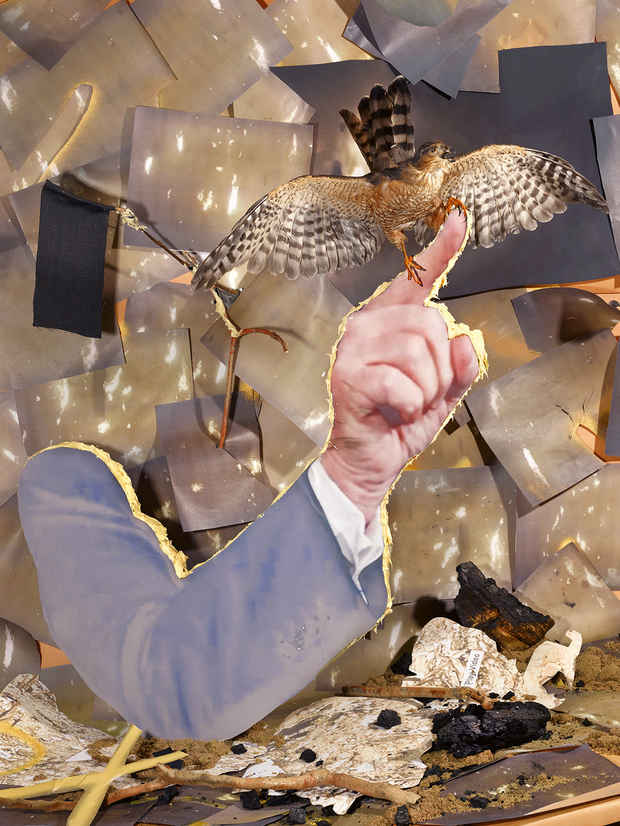Sheida Soleimani “Hotbed”
Denny Dimin Gallery

[Image: Sheida Soleimani "1/8/2020" (2020) Archival pigment print. 40 x 30 in.]
This event has ended.
Hotbed advances Sheida Soleimani’s inquiry into the crises that define Iran and the United States’ relations. Superimposing source imagery onto sculptural backdrops to illustrate the complex relationships between these hostile nations, Soleimani’s photographs are virtual palimpsests. Paradoxically, this paper-thin practice of layering foregrounds weighty ethical questions about how power operates, justice is served, and damage is done. These photographs reflect and critique and chop and screw hot button issues: demands for reparations, sanctions on trade and resources, and the “crude” history of the petroleum industry. Collectively, they induce atmospheres and moods that are agonizingly of the moment. Yet even as crises proliferate while media algorithms are increasingly geared to restrict our attention, Soleimani’s work produces the possibility of an otherwise and an elsewhere, modeling how we can create broader horizons of attention to include a multiplicity of crises.
Drawn from her newest series, Levers of Power, Hotbed (2020) most immediately treats Iran’s response to the COVID-19 pandemic. In the manner of a still life, the image freezes the arm of the deputy health minister of Iran in the act of wiping his brow, on the one hand isolating the gesture of a corrupt official, and on the other revealing the links between this public gesture and the country at large. Iraj Harirchi would be diagnosed with COVID-19 shortly after a press conference, even as his physical discomfort was then read as a sign of his unease with concealing the actual extent of the pandemic. Objects in the image invite viewers to build new readings: flypapered in the background are satellite images of mass graves dug for the pandemic dead, while lime, used to dissolve flesh, dusts grass and soil; a chain references sanctions on Iran, which had already thrown the country into economic depression. Other images in the room, including the Iran-U.S. finger-pointing diptych, 1/8/2020 and PS752, illustrate how technologies of power like “blame shifting” have become integral to the new global authoritarianism.
In the back room, Soleimani’s works excavate a prehistory of present-day crises, extending her examination of how relationships between Middle Eastern and Western leaders, institutions, and governments produce and are informed by exploitation, domination, corruption, profit, and abuse. Campy, sarcastic, and dark, each image targets a specific event within this history, satirizing the underbelly of trade wars and foreign policy circumventions. The images in the exhibition trace critical moments in the history of Iran and the US’s international relations, beginning with the 1953 Iranian coup. During the US-backed overthrow of Iran’s democratic government, for example, ‘YANKEE GO HOME’ became a rallying cry and symbol of the Iranian people’s discontent with Western intervention. In our present moment, this mantra sounds all the more urgent. The images comprising Hotbed enjoin us as spectators to evaluate moralities embedded in our viewing practices, not simply to avoid being complicit with larger structures of power, but also to learn how to speak truth to them.
Sheida Soleimani received her MFA from Cranbrook and her BFA from the University of Cincinnati. Soleimani’s most recent solo exhibitions were at Harlan Levey Projects in Brussels, Andrew Rafacz Gallery in Chicago and the evolving exhibition, Medium of Exchange, which has traveled to six different locations, including Edel Assanti in London. Soleimani has been written about in The New York Times, Artforum, Hyperallergic, The Brooklyn Rail, among many others. She currently is an Assistant Professor at Brandeis University in Waltham, MA.
Media
Schedule
from November 06, 2020 to December 23, 2020
Hours: Tuesday - Saturday, 11 am to 6 pm.